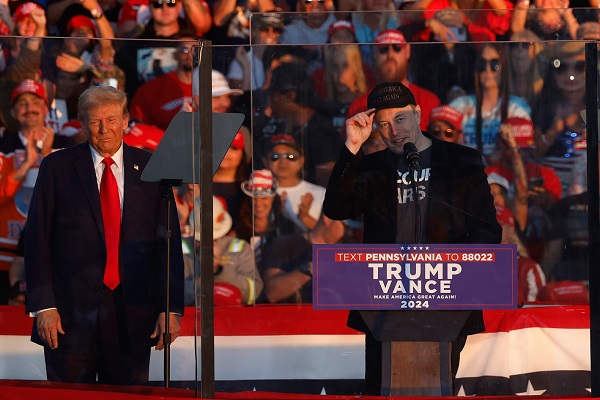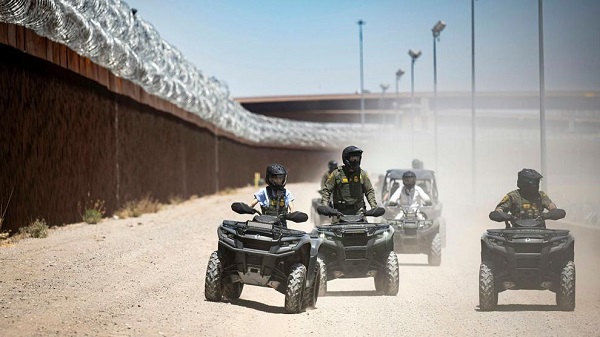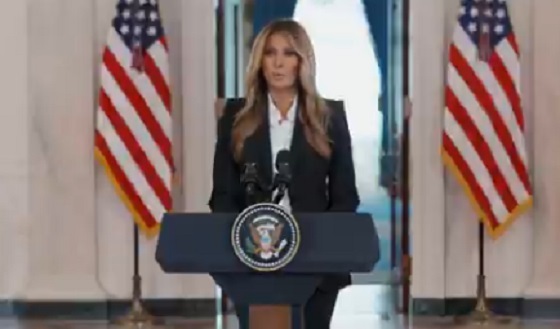International
Trump appoints Elon Musk, Vivek Ramaswamy to lead new Department of Government Efficiency

From LifeSiteNews
The president-elect has set a deadline of July 4, 2026, to ‘drive out the massive waste and fraud’ in the U.S. government.
President-elect Donald Trump announced that Elon Musk will lead a new Department of Government Efficiency (DOGE) with businessman and former Republican presidential candidate Vivek Ramaswamy.
“Together, these two wonderful Americans will pave the way for my Administration to dismantle Government Bureaucracy, slash excess regulations, cut wasteful expenditures, and restructure Federal agencies — Essential to the ‘Save America’ Movement,” Trump announced Tuesday on Truth Social.
Trump explained that the agency will “provide advice and guidance from outside of government and will partner with the White House and Office of Management & Budget to drive large scale structural reform, and create an entrepreneurial approach to government never seen before.”
The president assigned the duo a deadline of July 4, 2026, to “drive out the massive waste and fraud” that plagues our government budget, which has reached a mammoth size: $6.5 trillion per year.
Mogul and X owner Musk, who has been outspoken about the big problem of government waste, noted Tuesday that if the government is not made efficient, the country will go “bankrupt.”
He reposted a clip from a recent talk he gave in which he explained that not only is our defense budget “pretty gigantic” — a trillion dollars —but the interest the U.S. now owes on its debt is higher than this.
“This is not sustainable. That’s why we need the Department of Government Efficiency,” Musk said.
The U.S. debt has doubled since 2015 to reach $35.46 trillion, according to statistics shared by investor Mario Nawfal.
Musk has also shared to X reports that the Government Accountability Office “estimates the federal government wastes $247B in taxpayer money each year,” and that the Department of the Treasury reported $24.5B in “unreconciled transactions” — which means unknown items — in the past.
In an October interview with Tucker Carlson, Musk proposed that the amount of federal agencies should be cut from about 428 to 99.
Ramaswamy has similarly called for a “massive downsizing” of government bureaucracy after his appointment to DOGE.
Musk responded on X, “This is the only way.”
Ramaswamy has made clear, as has Musk, that cutting regulations is a key part of their mission at DOGE. Ramaswamy maintains that “eliminating bureaucratic regulations isn’t a mere policy preference” but “a legal *mandate* from the U.S. Supreme Court.” He cited on X the Supreme Court decision that, for example, “agencies cannot decide major questions of economic or political significance without ‘clear congressional authorization.’”
Musk shared Tuesday that all DOGE actions “will be posted online for maximum transparency,” adding, “Anytime the public thinks we are cutting something important or not cutting something wasteful, just let us know!”
Commentators have observed that Musk has already demonstrated a knack for organizational efficiency through his streamlining of the social media platform Twitter, which Musk rebranded as X.
illegal immigration
$4.5B awarded in new contracts to build Smart Wall along southwest border

Homeland Security Secretary Kristi Noem rides an ATV along the U.S.-Mexico border wall in El Paso, Texas, on April 28, 2025. Photo: Tia Dufour / U.S. Department of Homeland Security
From The Center Square
By
New contracts to add 230 miles of barriers, nearly 400 miles of technology
Roughly $4.5 billion in contracts have been awarded to expand border wall construction, including adding advanced technological surveillance along the southwest border.
Ten new construction contracts have been awarded through the U.S. Department of Homeland Security and U.S. Customs and Border Protection to add hundreds of miles of Smart Wall in California, Arizona, New Mexico and Texas.
“For years, Washington talked about border security but failed to deliver. This President changed that,” CBP Commissioner Rodney Scott said. “The Smart Wall means more miles of barriers, more technology, and more capability for our agents on the ground. This is how you take control of the border.”

Scott has championed advancing a Smart Wall border security system for years. A border security system is far more than a wall, he has told The Center Square, it’s an ecosystem.
The system encompasses steel and waterborne barriers, patrol roads, lights, cameras, advanced detection technology, including towers and aerostats, to provide Border Patrol agents with a range of tools to detect and interdict illegal activity.
CBP has published an interactive map to educate the public about the Smart Wall system. The map highlights areas of the 1,954-mile U.S.-Mexico border where wall construction has been completed, where border wall panels or waterborne barriers are under construction, where contracts have been awarded for proposed projects in the design phase or early construction, and planned construction areas that haven’t yet been awarded contracts.
Prior to Jan. 20, 2025, 702 miles of existing barriers had been constructed of primary wall and 76 miles of secondary wall, according to CBP data.
The new plan includes implementing barrier technology along 532 miles of the border where no barrier exists because of unfavorable terrain or remote location. It also includes deploying 550 miles of technology throughout previously constructed barriers, CBP says. Specific areas are also being built out in regions where contracts were previously canceled by the Biden administration.
In California, $483.5 million in taxpayer funding was awarded to BCCG Joint Venture for the Diego 1 Project to construct nine miles of new Smart Wall and 52 miles of system attributes in the San Diego Sector.
An additional $574 million was awarded to Fisher Sand & Gravel Co. for the El Centro 1 Project to construct eight miles of Smart Wall and install 63 miles of system attributes in the San Diego and El Centro sectors.
In California and Arizona, $199.5 million was awarded to Barnard Spencer Joint Venture for the Yuma 1 Project to construct 60 miles of system attributes in the Yuma Sector.
In Arizona, nearly $607 million was awarded to BCCG for the Tucson 1 Project to construct 23 miles of new secondary border wall and 66 miles of system attributes in the Tucson and Yuma sectors.
In New Mexico, $155.1 million was awarded to BCCG for the El Paso 1 Project to replace seven miles of old dilapidated barrier fencing in the Santa Teresa Area of Responsibility with a new Smart Wall. BCCG will also complete 22 miles of system attributes in the El Paso Sector in New Mexico.
Also in the El Paso Sector in New Mexico, Barnard Spencer Joint Venture was awarded nearly $579 million for the El Paso 2 Project to construct 23 miles of new Smart Wall and 81 miles of system attributes.
In the El Paso Sector in far west Texas, BCCG Joint Venture was awarded $850.4 million for the El Paso 3 Project to construct 42 miles of new primary Smart Wall, six miles of new secondary border wall and 46 miles of system attributes.
In Texas, BCCG Joint Venture was awarded $565 million for the Del Rio 1 Project to construct 22 miles of new primary Smart Wall, replace two miles of old barrier wall, and deploy 40 miles of waterborne barrier system in the Eagle Pass Area of Responsibility in the Del Rio Sector.
BCCG was also awarded $364.3 million for the Del Rio 2 Project to construct 10 miles of new primary Smart Wall, 23 miles of waterborne barrier system, and install 10 miles of system attributes in Eagle Pass.
BCCG was also awarded $96.1 million for the Rio Grande Valley Waterborne Barrier Project to deploy 17 miles of waterborne barrier in the Rio Grande River, south of Brownsville in Cameron County in the Rio Grande Valley Sector.
Another $550 million worth of contracts was also awarded to support Smart Wall construction. Additional construction and contracts are expected.
Funding for the projects comes from the “One Big Beautiful Bill,” which President Donald Trump signed into law. It also includes some fiscal year 2021 border wall appropriations that were frozen during the Biden administration.
Waivers were also issued by DHS Secretary Kristi Noem to expedite construction of nine miles in the San Diego Sector and 30 miles in the El Paso Sector in New Mexico. Both sectors were inundated with record high illegal traffic during the Biden administration.
International
Melania Trump quietly reunites children divided by Ukraine war

Quick Hit:
Melania Trump announced Friday that she’s maintained an “open channel” with Russian President Vladimir Putin, leading to the reunification of eight Ukrainian children with their families. The effort began with a personal letter she sent to Putin in August and has since expanded into coordinated talks between her representatives and Russian officials.
Key Details:
- During remarks in the White House grand foyer Friday, Melania Trump said, “A child’s soul knows no borders,” as she announced the reunification of eight Ukrainian children separated by the ongoing war.
- The first lady said she first reached out to Putin in a letter delivered during President Trump’s August 15 summit in Alaska, adding that “much has unfolded since President Putin received my letter.”
- Trump confirmed that “several backchannel meetings and calls” have since taken place, and that her representative has been working directly with Putin’s team to help connect displaced children with their families.
Announcement from First Lady Melania Trump @FLOTUS @WhiteHouse pic.twitter.com/zaOIhK8uAe
— Office of the First Lady (@FirstLadyOffice) October 10, 2025
Diving Deeper:
In an unexpected and emotional statement from the White House grand foyer Friday, Melania Trump revealed that her private outreach to Russian President Vladimir Putin resulted in the reunification of eight Ukrainian children with their families.
Trump said her involvement began with a letter to Putin, hand-delivered during President Trump’s August 15 summit in Alaska. “Much has unfolded since President Putin received my letter,” she said, describing how the correspondence evolved into a continuing dialogue between her office and Russian officials. “Since then, President Putin and I have had an open channel of communication,” she explained, adding that “several backchannel meetings and calls” have taken place to facilitate humanitarian coordination.
According to Trump, eight children have already been returned to their families within the past 24 hours — including one girl reunited with relatives across the Russia-Ukraine border — and “plans are already underway” for additional reunifications.
Trump framed the effort as part of her broader humanitarian mission to protect children affected by conflict. “A child’s soul knows no borders,” she said, emphasizing that political boundaries should never prevent the return of children to their loved ones.
She added that her representatives have been working directly with Putin’s team to locate and repatriate displaced minors. Several of the children involved in the latest effort were taken across borders during heavy fighting in eastern Ukraine, while others had been separated from relatives due to the chaos of war.
While details of the behind-the-scenes coordination remain limited, Trump’s announcement highlights the humanitarian possibilities that still exist even amid strained relations between the two nations.
-

 National1 day ago
National1 day agoCanada’s birth rate plummets to an all-time low
-

 Crime1 day ago
Crime1 day agoPierre Poilievre says Christians may be ‘number one’ target of hate violence in Canada
-

 Opinion16 hours ago
Opinion16 hours agoJordan Peterson needs prayers as he battles serious health issues, daughter Mikhaila says
-

 COVID-1912 hours ago
COVID-1912 hours agoDevastating COVID-19 Vaccine Side Effect Confirmed by New Data: Study
-

 Alberta1 day ago
Alberta1 day agoJason Kenney’s Separatist Panic Misses the Point
-

 Censorship Industrial Complex17 hours ago
Censorship Industrial Complex17 hours agoWinnipeg Universities Flunk The Free Speech Test
-

 Red Deer6 hours ago
Red Deer6 hours agoThe City of Red Deer’s Financial Troubles: Here Are The Candidates I Am Voting For And Why.
-

 Crime15 hours ago
Crime15 hours agoThe Bureau Exclusive: Chinese–Mexican Syndicate Shipping Methods Exposed — Vancouver as a Global Meth Hub

